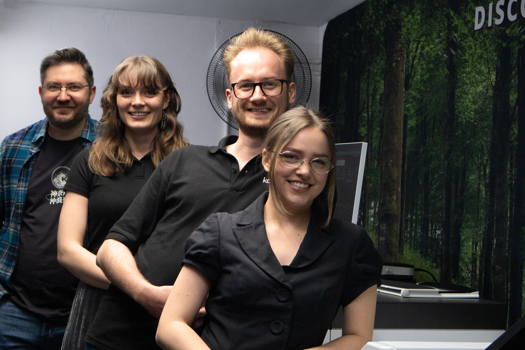The company was set up in 2002 by Chris Bottomley, who still owns and runs it as managing director. “It was set up for the repair of Heidelberg Cylinders and Platens and quickly evolved into a machine supplier to satisfy the need of supplying fully rebuilt machines,” he says. “A few years later the demand for an affordable hot foil blocking machine led us into pursuing that avenue. In conjunction with that there was a revival of letterpress printing so we moved on to supply that market.”
As the business grew, it moved several times. “Letterpress Services has always been based around the Wakefield area,” Bottomley says. “In the first six years we moved several times as our demand for space grew with the influx of work. 10 years ago we purchased the current unit at Horbury Junction, which has approximately 12,000 square feet (1,115sqm). It was purposefully refurbished for our specific needs from a much larger development. We had the opportunity to choose our own address, hence the name Letterpress House.”
Letterpress Services takes original letterpress machines, normally Heidelbergs but sometimes Miller Johannisbergs, and refurbishes them to as-new condition. Heidelberg hasn’t made letterpress machines since the early 1980s, but they were certainly built to last. Platens and cylinders are still commonly seen in many otherwise modern print works, often used for cutting and creasing work or foiling, though the small platens may be used for stationery and business card printing with the pressure turned up to give a fashionable embossed look.
Heidelberg used a clamshell action for its smaller A4 or A3 format letterpress platen machines, with the impression platen moving to contact the vertically mounted raised printing chase, rather like two hands clapping from joined wrists. They have a distinctive large oval or oblong metal guard plate embossed with the prominent ‘Original Heidelberg’ logo. These machines were nicknamed ‘windmills’, because of the distinctive clockwise rotating twin gripper arms that simultaneously move blank paper from the feed pile onto the platen bed while moving the previously printed sheet out and onto the delivery pile.
The Cylinder machines are more exactly termed ‘flatbed cylinders’ and are completely different from the rotary letterpress machines once used for newspapers. Here the bed that contains the raised printing surface can be large (up to A1 on some machines) and runs horizontally in and out under an impression cylinder that collects blank paper from the top feeder and after printing transfers it to the lower delivery.
Thanks to the adjustable pressure, letterpress platen and cylinder machines are particularly suitable for conversion for cutting and creasing work, where dies take the place of the printing chases. Electrically heated engraved metal pattern dies can be used to transfer hot foil onto paper, while if the pressure is wound up they can also block-emboss it too. Speeds in the 4,000 to 6,000sph range for cylinders can keep up with many digital presses.
“We sell an even number of machines for die-cutting and foiling on the larger S-line presses, however on sales of small A3 and A4 windmill platens then we do sell quite a lot of letterpress printing machines as well,” says Bottomley. “We even offer one A4 machine that is capable of printing, die cutting, embossing and gold foil blocking – this proves very popular with people wanting to do stationery from home, as it will happily plug into single-phase electrics.”
The current idea that heavily impressed print is somehow ‘authentic’ and even ‘artisan’ leaves older letterpress printers rather bemused, as they took pride in not indenting the paper. However, if you want perfectly smooth print nowadays you may as well use litho or digital. The only real reason to use letterpress other than sheer nostalgia is to get that embossed effect.
Indeed, Bottomley says that the desire for distinctive high-class stationery has now triggered a new demand. “The die-stamping machines we’ve recently moved into create a beautiful and very high-end form of printing, similar to letterpress except the matrix used for the print is an engraved ingot for intaglio print,” he explains. “Die stamping is typically a very expensive form of printing and used for the most high-end requirements. Alex Cain from Mount Street Printers in Mayfair is one of our most knowledgeable clients in the world of high-end die stamping.”
Converting for cutting and creasing and/or hot foil blocking usually means the inking train is removed from the presses. Otherwise they can be left in printing configuration. Foiling conversions gain a modern electronic control cabinet with display screen, looking slightly incongruous next to the solid cast metal ‘Original Heidelberg’ name plates on the press. Bottomley says “The LCD HMI/PLC display on the foiling units controls the foil rewind system, allowing you to program an initial short pull and then if required a step, or skip pull as it is often referred to. This is particularly useful when running a two-die job and enables you to run that particular job in one pass as opposed to putting the work through a second time, making the
HMI/PLC machine far more economical to run than a mechanical system.”
In a typical year Letterpress Services will rebuild about 20 presses, says Bottomley. “Gosh, over the years there have been many!” Apart from the UK and Europe, a lot of machines go to the US and the UAE. Even Covid hasn’t dented this: “The core of our work is centred around the packaging and greetings card industry and I feel that this hasn’t been affected massively by the Covid situation.”
Two levels of refurbishment are offered, called Gold and Silver. “The Gold Standard press is the top specification machine we offer,” says Bottomley. “The presses are fully rebuilt from the ground up and all worn and damaged parts are replaced. The press is supplied in the colour of the customer’s choice and is supplied with a full 24 months parts and labour warranty.
“Our most popular is the Silver Standard press. This is a real workhorse and is mechanically refurbished to an exceptional high standard. Unlike the Gold machine, we carry out far less aesthetics and concentrate on the mechanical performance. The machines are only offered in the original colours of black and grey, depending on their type. They are supplied with a 12 months parts and labour warranty.”
With so many old letterpress Heidelbergs still being used worldwide, finding machines to refurbish isn’t a problem, he says. “We have a fairly steady source of all models, however sometimes we can be limited by what is available in the market.”
All the refurbishment is done in-house by skilled engineers, says Bottomley. “We have six staff members. As the majority of the workforce is aged 50-plus the engineers have always been involved in the letterpress industry through its many guises.
“Very few parts are still available from Heidelberg so most parts we supply we have made by various specialist suppliers, such as gear grinders and cam manufacturers.”
All base machines are 40 or more years old and were built in an era with less stringent safety standards. Bottomley says: “Health and safety standards are actually only apparent when changing the presses’ uses, ie when converting from letterpress printing to die-cutting or foiling.
“Once a press is converted then it needs to meet all the new relevant safety standards and these can vary slightly in different areas. All the machines we supply conform to current HSE standards.”
Letterpress Services’ reputation has been built by word of mouth, Bottomley says. “We’re very proud of the fact that despite only advertising on our own website we have numerous clients that run one or more of our machines. We have great client relationships and client retention. We also receive a lot of recommendations through our existing client base, and I think that counts for a lot.”
This also leads to calls for help with existing letterpress installations, he says. “We’re in a very niche end of the market and we always seem to be the go-to guys should anyone require substantial repairs or servicing. We very often receive calls from customers that have been referred to us by Heidelberg when it can’t meet their needs.”
What are the best sellers? “Obviously we have certain service parts that are very popular, and there is always demand for the Heidelberg Cylinder SBG 560 770 press, due to the fact that it meets all the needs of the B2 market. We pride ourselves on meeting the needs and requirements of our clients who often need a bespoke package.”
Does he have a favourite press as a basis? “I’m particularly fond of the Heidelberg K-line range of small cylinders. I feel it’s massively underrated. It’s a very versatile machine and offers a slightly larger sheet size than the range of platens but its increased production speed and smooth running make it ideal for die-cutting and foiling.”
What are the future plans for Letterpress Services? “We have nothing new in development at present, however we are branching out into other aspects such as refurbishing Waite & Saville die-stamping presses and the Winkler range of envelope machines.”
STAR PRODUCT
Refurbished and converted B2-format Heidelberg Cylinder SBG 560 770 press.










